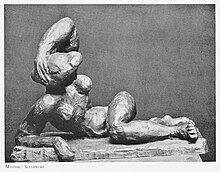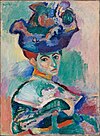Blue Nude (Souvenir de Biskra)
| Blue Nude (Souvenir de Biskra) | |
|---|---|
 | |
| Artist | Henri Matisse |
| Year | 1907 |
| Medium | Oil on canvas |
| Movement | Fauvism |
| Dimensions | 92.1 cm × 140.3 cm (36.3 in × 55.2 in) |
| Location | Baltimore Museum of Art,Baltimore |
Blue Nude (Souvenir of Biskra)(French:"Nu bleu, Souvenir de Biskra"), an early 1907 oil painting on canvas byHenri Matisse,is located at theBaltimore Museum of Artas part of theCone Collection.[1]
Matisse painted the nude when a sculpture he was working on shattered. He later finished the sculpture which is entitledReclining Nude I (Aurore).
Matisse shocked the French public at the 1907Société des Artistes Indépendantswhen he exhibitedBlue Nude (Souvenir de Biskra).Blue Nudewas one of the paintings that would later create an international sensation at theArmory Show of 1913in New York City.[2]
The painting, which may be classified asFauvist,was controversial; it was burned in effigy in 1913 at theArmory Showin Chicago, to where it had toured from New York. In 1907 the painting had a strong effect onGeorges BraqueandPablo Picasso,partially motivating Picasso to createLes Demoiselles D'Avignon.[3]

See also
[edit]- List of works by Henri Matisse
- 100 Great Paintings,1980 BBC series
References
[edit]- ^"Baltimore Museum of Art, Henri Matisse,Blue Nude (Souvenir of Biskra)".[permanent dead link]
- ^"Matisse, Henri." Encyclopædia Britannica Online, 2007. Retrieved 30 July 2007
- ^"Tyler Green, Modern Art Notes,The Response to Matisse's Blue Nude".Archived fromthe originalon 2013-02-27.Retrieved2012-08-17.

